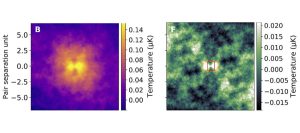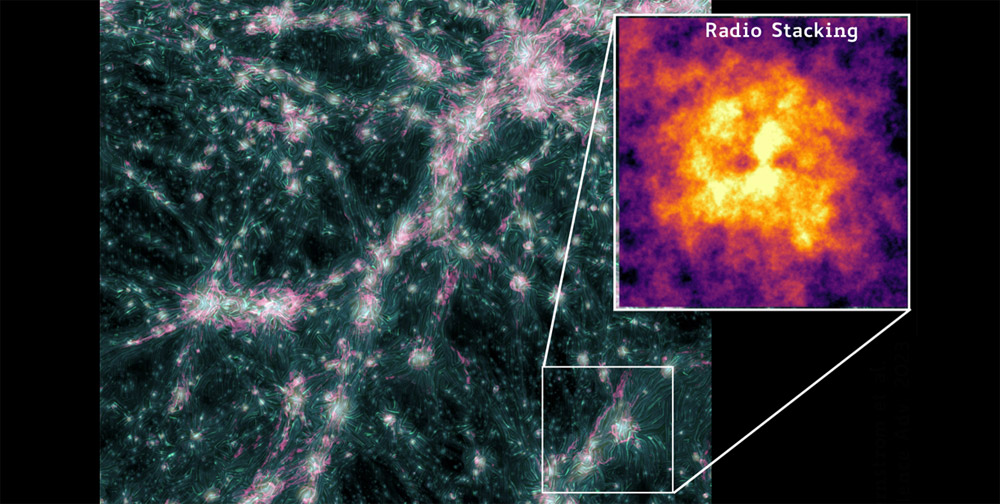Finally found: For the first time, astronomers have visualized faint echoes of primordial shock waves in the universe. These shock waves were released when the first matter arose from density fluctuations and the macro structure of the universe evolved in this way. Researchers have now detected these shock echoes via weakly polarized radio radiation released at that time by interactions with cosmic magnetic fields.
Galaxies, gas clouds and galaxy clusters form a giant cosmic web in the universe. The galaxy-rich nodes are connected to each other by gas-rich filaments, with vast “voids” in between – regions of low material density. This large structure of the universe arose from primordial density fluctuations shortly after the Big Bang. Then the denser regions collapsed into the knots and matter-rich filaments of the cosmic web.
Synchrotron radiation from early shock waves
According to current models, the formation of these first large cosmic structures produced massive shock waves that have left their mark to this day. “When matter fuses, it releases a shock wave that accelerates particles,” explains lead author Tessa Fernstrom from the University of Western Australia. Accelerated to nearly the speed of light, these electrons then emit high-energy synchrotron radiation when they interact with intergalactic magnetic fields – similar to the particle streams in today’s electron lasers.
This shock wave radiation echo should still be present along the cosmic web today. They should appear as faint, polarized radio emissions. “This is why the cosmic web should ‘glow’ in the radio spectrum, but because these emissions are so weak they are not clearly detected,” Fernstrom explains. Diffuse radio emission has only been detected in a few colliding galaxy clusters, but its source has remained unclear.
stalking by “stacking”
Only now has it been possible for the first time to clearly demonstrate this radiation resonance of primordial shock waves. Vernstrom and her team used radio data in the 1.4 GHz frequency band from the Global Magnetic Mesoscale Survey (GMIMS). On the other hand, they evaluated polarization maps of the cosmic background radiation from Planck’s satellite. According to the theory, the radiation resonance must be polarized in a certain way.
“Because only a few sources emit polarized radio radiation, there was less noise and we could better determine if we were actually seeing echoes emitting shock waves here,” Fernstrom explains. In order to amplify the very weak signals, the researchers also used a stacking method: They superimposed several images of pairs of galaxy clusters 3.6 and 50 million light-years apart.
“It is likely that such pairs are linked together by cosmic threads,” the astronomers explain. As a control, they carried out the same stacking procedure on unconnected clusters two billion light-years apart.

Polarization reveals the resonance of shock waves
The result: “In the case of connected galaxy clusters, we detect emissions between clusters in both frequency bands,” the astronomers report. This signal was absent in the control pairs. The faint radio emissions from the region between nearby galaxy clusters are also polarized by 20 to 60 percent, which is a lot by cosmic standards. “The radiation from ordinary galaxies is only slightly polarized,” the researchers explained.
From this data, Vernstrom and her colleagues deduced that the polarized radio emissions must be emanating from cosmic filaments between galaxy clusters – and thus from an ancient part of the large cosmic structure. “The strength and shape of the polarization signal together with the intensity confirm that we are indeed seeing the emission from the formation period of large cosmic structures,” the research team says.
Thus, for the first time, astronomers succeeded in showing the resonance of shock waves produced by the early formation of matter. This conclusion was also confirmed when, as a control, they again simulated the radiation resonance shape of these shock waves when observed using Planck and GMIMS. (Science Advances, 2023; doi: 10.1126/sciadv.ade7233)
Source: International Center for Radio Astronomy Research (ICRAR).

“Tv expert. Hardcore creator. Extreme music fan. Lifelong twitter geek. Certified travel enthusiast. Baconaholic. Pop culture nerd. Reader. Freelance student.”







More Stories
Space in City Hall has become more expensive
7 tips on how to learn to deal with your fears
“The kind of stone we were hoping to find.”